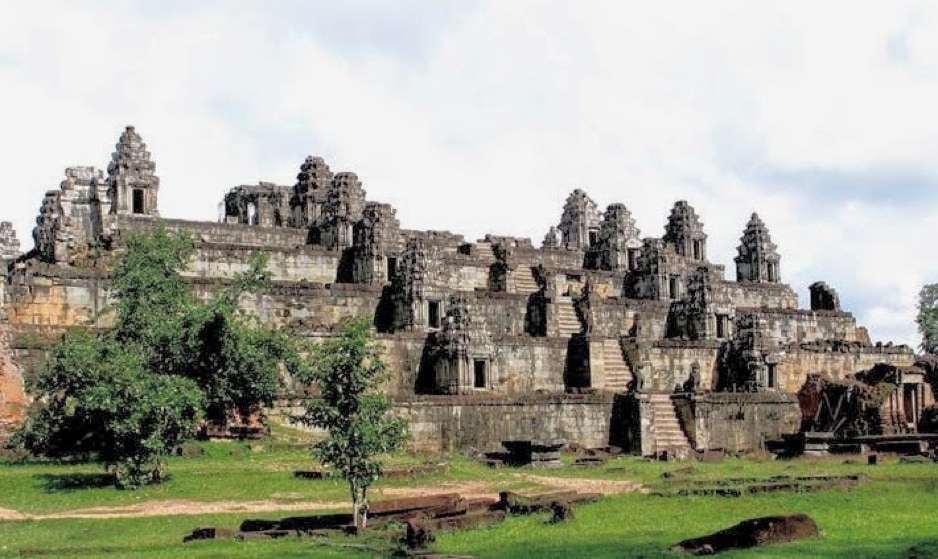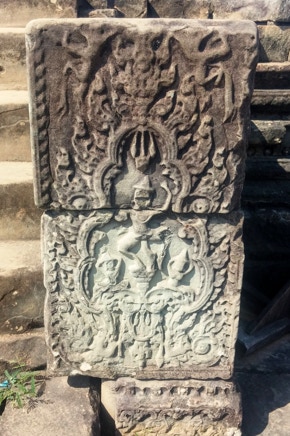IX. AEDICULAR PROLIFERATION:
Phnom Bakheng

When Yasovarman I (889-915) succeeded Indravarman I, he erected a temple in honor of his parents, as his father had for his at Preah Ko (879,) usually regarded as the first temple of the Angkorian era. This second ancestral temple, Lolei, was built in the middle of his father’s baray at Hariharayala (Roluos) setting a precedent for other later island temples such as East Mebon (953) built in Yasovarman’s own Yasoharatataka or East Baray by Rajendravarman, West Mebon (c.1055) in the West Baray by Udayadityavarman II and Neak Pean (c.1200) by Jayavarman VII in his own Jayatataka Baray. Then Yasovarman I built a new capital at Yasodharapura a few miles from the future sites of Angkor Wat and Angkor Thom, centered around his own state temple mountain located on the crest of an actual mountain, or at least a hill, rising 78m above the Angkorian plain named Phnom Bakheng (phnom is Khmer for hill.) Thus, he built not only a temple mountain but a mountain temple including the actual topography in the temple’s symbolic meaning, setting a precedent for more ambitious syntheses of nature and architecture such as Preah Vihear (11th Century) and Phnom Rung (1113 -1150.) At the same time Yashovarman I built Phnom Bakheng, he erected two less ambitious mountain temples, each composed of three shrines and ancillary buildings, on the summits of the only other hills in the area, Phnom Krom, 140m above the Tonle Sap lake to the south, and Phnom Bok, 240m above the future East Baray to the north, projecting vectors of authority from his temples across the entire Angkorian plain.
Like the Bakong, Yashovarman I’s pyramid had five-levels or terraces with a plinth on the uppermost one supporting a panchayatana or quincunx of shrines, surrounded on its terraces by sixty small shrines and forty-four medium-sized ones around its base. Phnom Bakheng thus turns an actual mountain into the cella or base of a five-tier man-made “temple mountain” which acts as its shikhara, with 108 shrines, each itself an aedicule of a temple mountain, strung around these five levels like the talas or haras of a Dravida vimana. Thus the temple itself, the towers of its panchayatana and those around its terraces and base could all be read as smaller replicas, “aedicules” and antefixes of the combined hill and pyramid, itself a symbol of the cosmic, “Platonic Form” of mountains, Mt. Meru, at whose base Phnom Bakheng sat, though at an incalculable distance from it. This creates an infinite regress of original and simulacrum, signified and signifier, as characteristic of Indic as postmodern thought.
Of all the temple mountains the Khmer built, Phnom Bakheng seems most cognizant of its possible Javanese precedent, Borobudur, (see figure 10,) in the multiple small, identical shrines lining its five terraces which are, however, too narrow to allow circumambulation, thus precluding the need for mural bas reliefs and the didactic purpose of its putative original. The forty-four large shrines surrounding the pyramid’s base also recall the phalanx of 224 pevara or guardian candi or small shrines standing watch at Candi Siwa at Roro Jonggrang (Prambanan,) Java. Nonetheless, the Bakheng’s 108 shrines would be an impressive number of aedicules on the shikhara of all but the most ambitious Indonesian and Indian temples.
A Khmer Stonehenge?
Man the Measurer or All Things
Phnom Bakheng, like every other Khmer monument, is constructed using precise mathematical calculations, leading some to the conclusion it must have functioned as some sort of astronomical or astrological instrument, at a time when there was no distinction between the two. In the absence of historical evidence, an exegete is free to choose among a plethora of possible sidereal phenomena and methods of measuring Khmer temples which are necessarily somewhat arbitrary. These have included: number of footsteps, (but whose foot?) distance from the outer edges of a structure (generally used in this introduction,) distance from a structure’s center, ratios of a temple’s length, width or diagonal, its intercolumniation, its inter-fenestration, arc-seconds of the azimuth or path of the sun or moon, etc. Under these circumstances, most such theories must be regarded as ingenious or merely ingenuous, creative or simply credulous, suggestive or just obsessive. Jean Fillozat of the EFEO, École Française d’Extrême Orient, for example, noticed that from any point around the Bakheng only thirty-three shrines are visible – which coincides with the number of years it takes a lunar calendar of 354 days and solar calendar of 365 to come into sync, (as well, one might add, as the number of Vedic deities, the levels of consciousness in Buddhist cosmology, Christ’s age at his death, a third of one hundred and any number of other related and unrelated phenomena.) He also noted that each quadrant contained twenty-eight towers, equal to the days of a four-week lunar month, while six times the sixty terrace shrines plus the five towers on their summit equals 365, the days in a solar year. With a little more arithmetic, one could soon discover that a four year lunar cycle has 1416 days and a solar or Gregorian cycle, 1461 days, the same four digits and hence the same sum, twelve, equal to the number of months in a year (or hours of sunlight at the equinox, half a 24-hour day or eggs in a dozen, for that matter.) These two four-year cycles are also forty-five days out of sync, the number of the 44 shrines around the base plus the central one. Phnom Bakheng, the temple itself, could even be pressed into service to provide the “intercalation” or “embolism” of 366 shrines each leap year. Since any of these congruities may have resulted from serendipity or even wishful-thinking, the only conclusion to be drawn from them is that the temple could have functioned as an observatory, - not that it did.
Numerology figured as prominently in the Vastu Shastra and Khmer life as astrology with which it is intertwined; it determined the date to begin a temple’s construction or to start a war; it was used to calculate the size of a pada for a mandala; the “sum” of the letters of a donor’s name could decide which god a temple honored and almost every number had numerous interpretations. Special attention was paid to the ratio between the dimensions of a temple’s parts, like Pythagoras’ or Palladio’s harmonic fractions or Corbusier’s “golden mean ratio” or “modulor.” For example, 108, the number of shrines at Phnom Bakheng (less the center one) was regarded as especially auspicious since 108 has so many “auspicious” factors – 2, 3, 4, 6, 9, 12, 18, 27, 54, (although, as noted, most numbers could be auspicious, ominous or both.) The sum of the digits in 108 equals nine; a “magic square” can be constructed around that number because as the initial digits of its multiples increase, their final digits decrease by an equal amount, so all equal nine – 18, 27, 36, 45, 63, 72, 81, 90, 108, 117, 126, 135, 144, 153, 162, 171, 180, 207, 216, 225, 234, 243, 252, 261, 270, 432. (99 might appear to present an exception but adding 1 to 9 =10 while subtracting 1 from 0 = equals -1, the sum of which is also 9; although the Indians invented zero they overlooked negative numbers, so this anomaly may have caused needless perplexity.)
The fact that the total number of shrines is 109 not 108 might also seem to present a problem but, in fact, it would only have made that number more auspicious from the point of view of temple’s shthapakas or architects, since 109 is an irrational number and therefore cannot be factored, endowing it with both mystery, unity and “adamantine” invulnerability. The Vastu Shastra, attached special significance to a number’s “remainder” after factoring; this might be related to the consistent asymmetry of Khmer temples, their unfinished state or simply an irrational fascination with the irrational, closely allied to the numerological, the magical and hence the sacral. 109’s remainder is one, the uniquely indivisible singularity and origin of all other numbers, thus associated with the primal bindu, the seed of all, the absolute, Brahman, atman, the uncreated creator and primum mobile. Buddhism is more rigorous numerologically than Hinduism: since zero precedes even one, sunyata or nothing is regarded as the ultimate uncreated or not “dependently originated” reality.
VIEW FROM THE SOUTHEAST EDGE OF THE 1ST ENCLOSURE, PHNOM BAKHENG (907)

SHIVA, 5TH TERRACE, PHNOM BAKHENG (907)
´